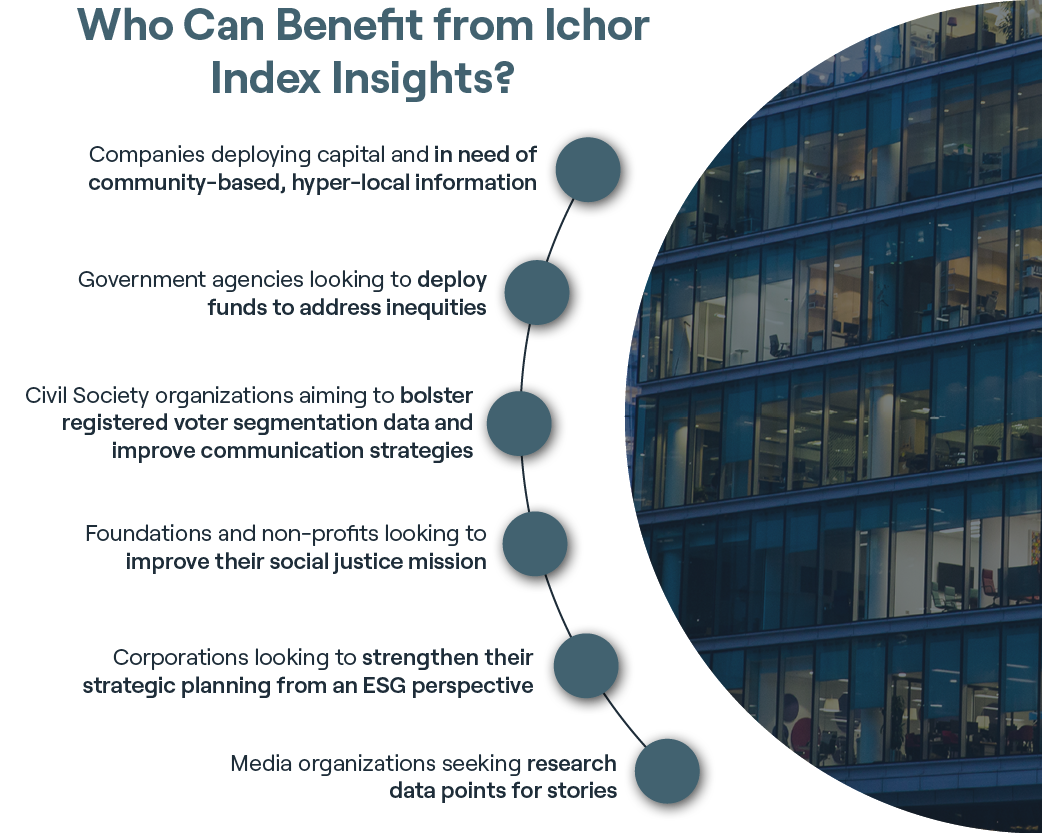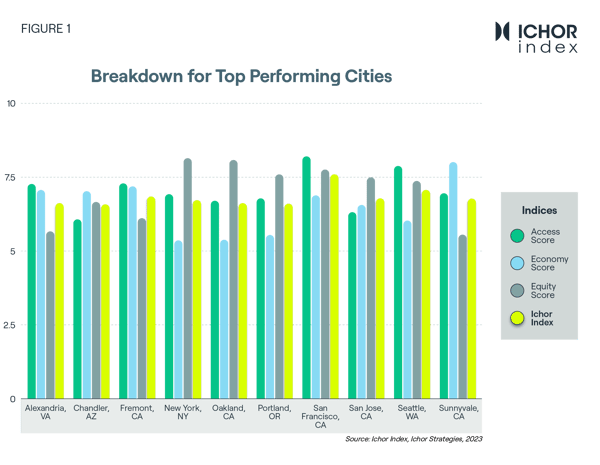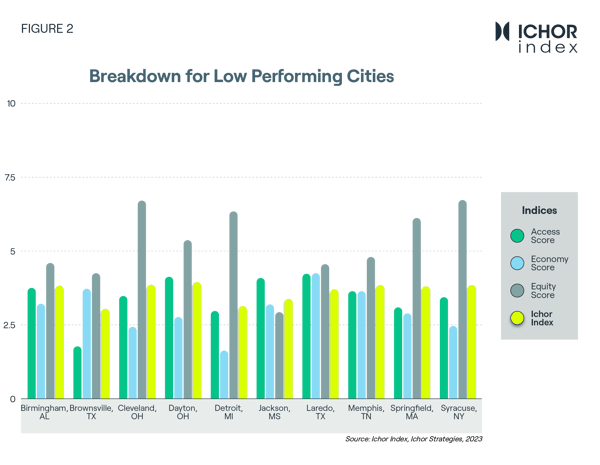The Ichor Index is a data-driven and adaptive tool that provides a quantitative framework for understanding key issues in cities and neighborhoods to develop impactful strategies.
The Ichor Index quantifies the intersectional relationship between infrastructure, resources, and the economy within urban areas to better understand the quality of life. The Index analyzes areas across three indices: Access, Economy, and Equity. Each of these is composed of sub-indices that provide nuance across pain points such as education and healthcare access. The Ichor Index and its components are on a scale from one to ten, with ten representing the best performance. In its current iteration, the Ichor Index has been calculated for the 200 largest U.S. cities by population, using 2021 census-tract-level data from the U.S. Census Bureau.

The Ichor Index in Action
 Figure 1: Shows values for the Ichor Index and its categories for the ten best-performing cities.
Figure 1: Shows values for the Ichor Index and its categories for the ten best-performing cities.
Figure 1 – broken down by Access, Economy, and Equity – illustrates trends for top-performing cities:
- Better performance is driven by higher Equity scores but impeded by lower Economy scores.
- Equity scores trend higher than Access scores, indicating these cities are better at sharing resources across demographic groups than providing access to the population at-large relative to other cities.
- Equity scores trend higher than Economy scores for top cities, indicating a disconnect between efforts to provide equitable access to resources and improve economic conditions.
In our work with a Fortune 250 financial services company, we helped the client understand how to effectively scale its racial equity initiative to more cities. Ultimately, we curated a list of markets where Black communities lack access to the resources which our client’s workstreams and products were best suited to address.

Using the Index as a foundation, Ichor’s team of strategists and analysts can help organizations pinpoint where to make connections between people and resources, and design strategies and communications plans to reach these communities and bolster company reputation.
 Figure 2: Shows values for the Ichor Index and its categories for the ten lowest-scoring cities.
Figure 2: Shows values for the Ichor Index and its categories for the ten lowest-scoring cities.
Low performers are largely concentrated in the South. Demographic trends reveal that Black residents, on average, make up 9.7 percent of the population in the ten top-performing cities, compared to an average 43.0 percent in the ten lowest-performing cities. This trend reverses for cities with larger white population shares, which are 41.1 and 24.4 percent for top and bottom performers, respectively.
Figure 2 depicts the relationship between the Index and its component scores for the lowest-performing cities:
Economy scores are consistently poor, but Equity scores trend significantly higher than Access scores.
In the case of Jackson, Mississippi, Access is much higher than Equity, indicating an imbalance between the resources provided at large and the demographic communities that can access them.
- Detroit, Michigan’s economy fares the worst but achieved the highest Equity score, indicating that it may provide a good model for distributing resources in a struggling market.
Corporate Decision Making – How Amazon Could Have Done Better
For an example of how the Ichor Index can help mitigate risk, we can look at critical choices companies need to make to drive revenue growth. One good example, Amazon’s high-profile decision on its second headquarters.
New York City offered Amazon nearly $3 billion in government incentives to build an expansive second headquarters that promised to bring economic development and 25,000 jobs to Long Island City, Queens. However, the tech company faced intense backlash from key stakeholders including lawmakers, union leaders, and activists. According to polls, Amazon’s development was generally well-received across the city and state, but it was local resistance, local communities, and local issues that created and sustained backlash against the company, which ultimately hurt its reputation and ended its bid to make NYC its second home.
This is where the Ichor Index offers a solution.
By providing hyper-local insights that analyze geographies down to the neighborhood level, the Index illuminates issues facing communities that would inform a more thoughtful engagement strategy. Using the sub-indices, the Index would have pointed to real problem areas and provided the data needed to craft solutions that build trust with communities and value for business.
Using the Index to look at the current issues in Long Island City, Queens, we see:
- The neighborhood performs above average with an overall Index score of 6.41.
- However, the neighborhood has an Equity score of 4.62, indicating that disparity is concentrated in certain demographic groups.
- Looking at Equity sub-indices, Long Island City performs poorly in poverty, unemployment, and transit – signaling potential community concerns around rising costs and displacement.
- Despite relatively strong economic performance (Economy score of 7.13), the neighborhood has weaker education access, which could be driving the gap with the median household income sub-index (5.40).
Using the Ichor Index, Amazon could have identified parts of the neighborhood and surrounding area that would have benefitted most from solutions like workforce development programs, investing in local educational institutions and infrastructure, thus demonstrating a commitment to the community and building lasting trust.
In our work with a Fortune 10 company involved in distributing COVID-19 vaccines, we used our data-driven practice and community insights to understand barriers in priority markets our client needed to overcome such as internet and transportation access, and mistrust of the medical profession. This enabled Ichor to craft a flexible strategy connecting COVID-19 vaccinations to the communities that needed them most, optimizing our client’s impact on community health.

What Does it Mean for You?
Conscious consumers and stakeholders across the value chain have forever altered the way organizations can approach growth. Whether exploring new or expanding existing markets, business leaders must think about the equitable impact associated with their every move.
That’s where the Ichor Index comes in. As a comparative ranking, it helps business and civic leaders prioritize markets and better understand if cities are performing well or facing a higher rate of socioeconomic challenges.
Moving Forward
Quantifying a city doesn’t come without its challenges. Each is comprised of its own unique blend of history, challenging socio-political landscapes, and core economic drivers.
The Ichor Index is just one part of developing a sustainable community strategy. The Index’s data-driven framework, coupled with Ichor’s unique community insights and hyper-local research, allows for a tailored approach for clients to confidently enter markets with the knowledge to meaningfully engage communities. This powerful tool makes gaps in equity more visible and ultimately allows organizations to be more informed about the locales they are or want to do business in.

